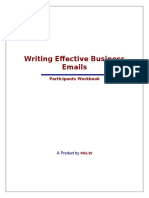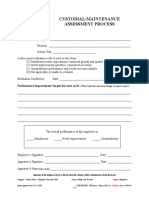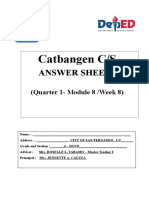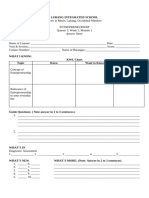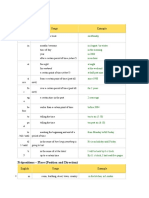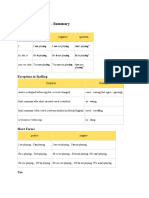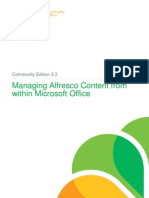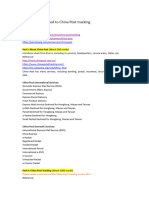E-Mail Work Book
E-Mail Work Book
Uploaded by
J.Gopala KrishnaCopyright:
Available Formats
E-Mail Work Book
E-Mail Work Book
Uploaded by
J.Gopala KrishnaCopyright
Available Formats
Share this document
Did you find this document useful?
Is this content inappropriate?
Copyright:
Available Formats
E-Mail Work Book
E-Mail Work Book
Uploaded by
J.Gopala KrishnaCopyright:
Available Formats
A Guide To Effective E-Mail
A Guide To Effective E-Mail
Page 1 of 45 Satyam Learning Center Version 1.0
A Guide To Effective E-Mail
Exercise 1
Why is e-Mail writing, a challenge?
List down a few key characteristics that enhance/limit the effectiveness of
each of the following mediums of communication:
Face-to-Face
____________________________________________________________________
____________________________________________________________________
____________________________________________________________________
Telephone/Teleconferencing
____________________________________________________________________
____________________________________________________________________
____________________________________________________________________
____________________________________________________________________
____________________________________________________________________
____________________________________________________________________
Why is e-mail writing, a challenge?
____________________________________________________________________
____________________________________________________________________
____________________________________________________________________
____________________________________________________________________
Page 2 of 45 Satyam Learning Center Version 1.0
A Guide To Effective E-Mail
Exercise 2
Subject Line
Re-write the following ineffective Subject Lines. Use a signal word and
summarize what your readers should do and know.
#1
Subject: Copy Machine
I recommend we request a new copier in the annual budget. For the past 6
months, we have had to repair our copy machine on an average of twice
weekly. Needless to say, repair costs and productivity losses have been
substantial.
____________________________________________________________________
#2
Subject: Form C82
I have enclosed a draft of Form C82.
Request you to review and edit the draft by Monday, July 8, so that we can get
your perspective on its design and layout.
___________________________________________________________________
Page 3 of 45 Satyam Learning Center Version 1.0
A Guide To Effective E-Mail
Exercise 3
Choose the right word
Test your sensitivity to small differences in meaning by choosing the right
word in the following sentences:
1. Please connect me to the ______________________.
a. person concerned
b. concerned person
2. We shall send you an ______________________of the report.
a. updation
b. update
3. Please ______________________the content of the letter.
a. improvise
b. revise
4. I am not able to ______________________ with the pressure.
1. cope
2. cope up
5. ______________________ the project can be completed by the end of
this month only.
a. According to me
b. I feel
6. I ________________________to your response.
a. look forward
b. am looking forward
7. Let’s ________________________the constraint with the client in the
telecon this evening.
a. discuss
b. discuss about
8. I ________________________completing module 1 latest by tomorrow
evening.
a. would
b. will be
9. I ________________________your support in understanding the problem.
a. request
b. request for
Page 4 of 45 Satyam Learning Center Version 1.0
A Guide To Effective E-Mail
Exercise 4
Avoid Wordiness
Business communication should be as brief and easy to read as possible.
Rewrite the following sentences in brief:
1. Let us hold a meeting for the purpose of discussing the status of the
project.
_________________________________________________________________
_________________________________________________________________
2. During the course of the meeting it was decided that, for all intents and
purposes, it is imperative that important files should have a backup in the
server.
_________________________________________________________________
_________________________________________________________________
Page 5 of 45 Satyam Learning Center Version 1.0
A Guide To Effective E-Mail
Exercise 5
Positive Language
Accent the positive.
Replace the following negative words with positive ones.
1. Your department’s needs will not be reported if you fail to submit the
required data.
_________________________________________________________________
_________________________________________________________________
2. Unfortunately, we refuse to give customers a definite quotation until
they let us know the end use of their system.
_________________________________________________________________
_________________________________________________________________
3. The material you ordered can’t be shipped until July 2. We can’t give
you a decision on your claim until you have completed the S-4567 form.
_________________________________________________________________
_________________________________________________________________
4. It is very unfortunate that the dimensional clarifications reached us very
late to incorporate the necessary changes.
_________________________________________________________________
_________________________________________________________________
Page 6 of 45 Satyam Learning Center Version 1.0
A Guide To Effective E-Mail
Exercise 6
Parallel Structure
Use parallel structure, particularly within lists.
Parallel structure: Phrases that repeat the same grammatical structure.
Explanation: Parallelism enables readers to read documents more
efficiently.
Below is an example of non-parallel structure. Incorporate the parallel
structure:
1. Currently, the company has:
No defined future goals.
Shortsighted without budget and long term mission.
Merit system.
Do not appear prepared to meet rapid changes."
_________________________________________________________________
_________________________________________________________________
_________________________________________________________________
_________________________________________________________________
2. The analysis will include planning, organizing, dividing and assessment of
turnaround functions.
_________________________________________________________________
_________________________________________________________________
3. The Interface Team will be responsible for integrating the functional units
developed by the QA Team and for the execution of the model test matrix.
_________________________________________________________________
_________________________________________________________________
Page 7 of 45 Satyam Learning Center Version 1.0
A Guide To Effective E-Mail
Exercise 7
Imperative Voice
Use the imperative voice for recommendations
Imperative Voice: Begins with a verb, assumes the subject, "you."
Explanation: The imperative voice is concise and eliminates the moral tone
of "should" and the overly emphatic tone of "must."
Change the non imperative voice to imperative voice:
1. The value of middle management should be recognized.
_________________________________________________________________
2. Self-managed work-teams must be created for effectiveness.
_________________________________________________________________
Page 8 of 45 Satyam Learning Center Version 1.0
A Guide To Effective E-Mail
Exercise 8
Active Voice
Put more action into your sentences by using active voice rather than
passive voice verbs. Passive voice verbs are generally longer in length and
don’t get to the point as quickly. Change the passive to active voice in the
sentences below.
1. From my end the document was released for review to the functional team
on 20th morning.
_________________________________________________________________
_________________________________________________________________
2. Based on your and Mahesh’s understanding regarding the change request,
the design document may be suitably modified.
_________________________________________________________________
_________________________________________________________________
3. The report was read by a dozen people.
_________________________________________________________________
4. Your efforts are appreciated by all of us.
_________________________________________________________________
5. Your case will be discussed by a committee.
_________________________________________________________________
Page 9 of 45 Satyam Learning Center Version 1.0
A Guide To Effective E-Mail
Exercise 9
Avoid Redundancy
Avoid Redundancy: Identify redundant expressions in the sentences below.
1. In the near future, we will take the consensus of opinion of the general
public before we actually submit our course of action.
______________________________________________
2. The meeting has been postponed until later.
______________________________________________
3. Enclosed please find the details of the module.
______________________________________________
4. Please revert back for further details
______________________________________________
5. Can you let me know the status of the work as of now?
______________________________________________
6. Please repeat the instructions again
______________________________________________
Page 10 of 45 Satyam Learning Center Version 1.0
A Guide To Effective E-Mail
Exercise 10
Trite Expressions
Below are a few trite expressions. Give them a fresh look:
1. Attached hereto/Attached herewith/ /Enclosed herein/I hereby
________________________________________________________________
2. We have done as per the instructions
________________________________________________________________
3. We are forwarding the report for your perusal…..
________________________________________________________________
4. Pursuant to your inquiry…
________________________________________________________________
5. Kindly be advised that…
________________________________________________________________
6. I solicit your comments on this.
________________________________________________________________
7. Thanking you for your kind consideration.
________________________________________________________________
8. Thanking you in anticipation…
________________________________________________________________
Page 11 of 45 Satyam Learning Center Version 1.0
A Guide To Effective E-Mail
Exercise 11
Avoid Sexism
Avoid Sexism communication. Rewrite the following sentences:
1. By the 15th of each month each associate is expected to report the progress
of his current project.
_________________________________________________________________
_________________________________________________________________
2. Please meet the salesmen of the company.
_________________________________________________________________
_________________________________________________________________
3. Could you keep us posted on manpower requirements of your unit?
_________________________________________________________________
_________________________________________________________________
4. The project is estimated to involve 1000 man hours.
_________________________________________________________________
_________________________________________________________________
Page 12 of 45 Satyam Learning Center Version 1.0
A Guide To Effective E-Mail
A Guide To Effective E-Mail
Presentation
Page 13 of 45 Satyam Learning Center Version 1.0
A Guide To Effective E-Mail
Writing Effective Emails
Writing: A Challenge
Oral Written
Fact to Face: Words
Words
Voice
Body Language
Telephone / Teleconference
Words
Voice
Page 14 of 45 Satyam Learning Center Version 1.0
A Guide To Effective E-Mail
Contemporary Writing is
READER CENTRIC
( NOT writer centric)
Why is good writing important?
Good writing ensures that the content is
showcased well
A poorly written manuscript sends the signal
that
one does not consider his/her writing worth
improving
one does not respect the reader enough
Page 15 of 45 Satyam Learning Center Version 1.0
A Guide To Effective E-Mail
WRITING ESSENTIALS
The ‘LESS’ Approach
LANGUAGE
ETIQUETTE
STRUCTURE
STYLE
STRUCTURE
Subject Line
( Signal word+ do/know statement)
Text of the mail
Flow from specific to generic ( Pyramid structure)
Lend to Skimming & Scanning
Page 16 of 45 Satyam Learning Center Version 1.0
A Guide To Effective E-Mail
STYLE
Use expressions/words that are (SAP):
Specific
Active
Positive
Avoid expressions that are (STARP):
Sexist
Trite
Redundant
Parallel in nature
LANGUAGE
Edit for ( GAS) :
Grammar
Appropriateness
Spellings
Page 17 of 45 Satyam Learning Center Version 1.0
A Guide To Effective E-Mail
ETIQUETTE
Send only messages that are work related
If your message is very important, controversial,
confidential, or could easily be misunderstood, use
the telephone or set up a face-to-face meeting
“Crying wolf”:
Use the “urgent message”notation sparingly.If you
use it often your future messages may be ignored.
Use of all capital letters suggests “Shouting”
Use a salutation and a subscription
Write a subject line
Use discretion while including names in the To
and Cc list
Ask for a receipt only if required
Page 18 of 45 Satyam Learning Center Version 1.0
A Guide To Effective E-Mail
THE “WATCH WORDS” RULE
Write from the reader’s viewpoint
Aim at specific objectives
Throw out antiquated expressions
Choose words that draw pictures
Have action in your words
THE “WATCH WORDS” RULE
Write short sentences
Organize for interest and action
Remember what you’d say on the telephone
Develop your vocabulary
Simplify and spell check
Page 19 of 45 Satyam Learning Center Version 1.0
A Guide To Effective E-Mail
Write…
To be understood
To prompt a response
To convey a positive impression about who
you are and what you do
After you have finished writing, ask yourself:
Have I said what I wanted to say?
Have I said it clearly?
Have I said it concisely?
Have I said it in the most effective manner
possible?
Page 20 of 45 Satyam Learning Center Version 1.0
A Guide To Effective E-Mail
Practice is the best of all
instructors ......P. Ovidus
HAPPY WRITING!
Page 21 of 45 Satyam Learning Center Version 1.0
A Guide To Effective E-Mail
A Guide To Effective E-Mail
Reading Material
Page 22 of 45 Satyam Learning Center Version 1.0
A Guide To Effective E-Mail
Writing Essentials
The four elements that are essential in writing effective e-mails are listed as
follows:
Language
Etiquette
Style
Structure
Less these elements in their appropriateness, e-mails do not have the desired
impact on the reader.
Language
This is not only important because improper spelling, grammar and punctuation
give a bad impression of your company, it is also important for conveying the
message properly. E-mails with no full stops or commas are difficult to read
and can sometimes even change the meaning of the text. And, if your program
has a spell checking option, why not use it?
Etiquette
One needs to follow certain etiquette rules for the following 2 reasons:
Professionalism:
By using appropriate email etiquette your company will convey a
professional image.
Efficiency:
Emails that get to the point are much more effective than poorly worded
emails. Importantly, the ‘content’ may be misunderstood, when basic
etiquette is not followed.
Page 23 of 45 Satyam Learning Center Version 1.0
A Guide To Effective E-Mail
Structure
Since reading from a screen is more difficult than reading from paper, the
structure and lay out is very important for e-mail messages. Use short
paragraphs and blank lines between each paragraph. When making points,
number them or mark each point as separate to keep the overview.
Subject Line
Subject line= Signal word + do/know statement
Signal words signal the intent of the mail. Examples of a few signal words:
Recommendation for
Update of
Status of
Request for
Approval on/for
Invitation to
Presentation on
Review of
Status of
Response to
Clarification on
Do/ Know statement: This statement signifies what the reader of the mail
should do or know.
Style
Be Specific and to the point
Do not make an e-mail longer than it needs to be. Remember that
reading an e-mail is harder than reading printed communications and a
long e-mail can be very discouraging to read.
Use Active instead of passive
Try to use the active voice of a verb wherever possible. For instance,
'We will process your order today', sounds better than 'Your order will be
processed today'. The first sounds more personal, whereas the latter,
especially when used frequently, sounds unnecessarily formal.
Use Positive language
Page 24 of 45 Satyam Learning Center Version 1.0
A Guide To Effective E-Mail
Also…
Keep your message gender neutral
In this day and age, avoid using sexist language such as: 'The user should
add a signature by configuring his email program'. Apart from using
he/she, you can also use the neutral gender: ''The user should add a
signature by configuring the email program”.
Avoid trite, redundant and parallel expressions
Good business writers avoid using trite, redundant and parallel words
and phrases which destroy the effective, efficient business image
conveyed in business messages. The following is the list of most common
trite/redundant/parallel expressions and their improved versions.
Stereotyped Improved Version
above-numbered policy your policy; this policy
complete (using both words is
absolutely complete
redundant)
according to our records we find
(avoid using at the beginning of
acknowledging your
message)
(avoid using at the beginning of
answering your
message)
agreeable and satisfactory (use only one to avoid redundancy)
a large number of (be specific)
allow me to express (just say it)
along the lines of like
anxious and eager (avoid) "I look forward to. . . "
anywheres (no such word)
are of the opinion that believe
as a matter of fact (avoid)
as in the above (be specific)
as per acknowledge
as per your request as you requested
as yet still
Page 25 of 45 Satyam Learning Center Version 1.0
A Guide To Effective E-Mail
at a later date later (be more specific)
at all times always
at an early date (be more specific)
attached find; attached hereto The attached brochure. . . (adj)
at the present time now; at present; presently
at which time when
beg to remain (avoid)
claim asserted; stated
consensus of opinion consensus (entire phrase is redundant)
costs the sum of costs
courteous and polite (use only one word)
despite the fact that though, although
due to the fact that since; because
duly (avoid)
during the time that while
during the year of 1991 during 1991
during this period of time meanwhile; during this time
each and every one of use each of us; everyone; all of us;
enclosed herewith (use enclosed as an adjective)
esteemed (avoid)
exactly identical identical
feel free to please. . .
first and foremost (use just one word, not both)
first of all first
for the month of May for May
for the period of a year for one year
for the purpose of to; for
for the purpose of learning to learn
for the reason that since; because
full and complete (use just one word, not both)
give consideration to consider (avoid camouflaged verbs)
hold in abeyance postpone
hope and trust (avoid; violates success consciousness)
if and when (use just one word, not both)
Page 26 of 45 Satyam Learning Center Version 1.0
A Guide To Effective E-Mail
inadvertently unintentionally
in a position to able to
inasmuch since
indemnify protect
in due course; in due time (give specific time)
in lieu of instead
in order that so
in re (avoid)
in regard to regarding
in the amount of for
in the city of in
in the event that if
in the near future soon (or be specific)
in this day and age today
in view of the fact that since; because
insist and demand (use just one word; not both)
in spite of the fact that because; although
kindly advise please let us know
know-how technical knowledge; expertise
let us hear from you please write us
make an adjustment in adjust
make inquiry that inquire
my personal opinion my opinion (opinions are personal)
not in a position unable
of the opinion that believes
on the grounds that because
pending receipt of until
per diem daily rate
permit us to state (avoid)
please be advised that (avoid)
please do not hesitate to write please write
pursuant to our agreement as we agreed
refer back to refer to
remember the fact that remember
Page 27 of 45 Satyam Learning Center Version 1.0
A Guide To Effective E-Mail
reply response; answer
right and proper (use just one word; not both_
sometime in the early part of the coming
early next month
month
subsequent to after
take this opportunity (avoid)
taking the liberty of (avoid)
thanking you in advance (avoid)
the reason is due to because
this letter is to inform you (just say it)
thought and consideration (use just one word; not both)
(since facts are true, omit the
true facts
adjective)
until such time when
we are not in a position to we cannot
we are of the opinion that we believe
we hope; we trust (avoid; violates success consciousness)
without further delay now; immediately
with reference to; with respect to about
with regard to regarding; concerning
you failed to enclose please enclose. . .
you neglected to sent (restate in positive terms)
Page 28 of 45 Satyam Learning Center Version 1.0
A Guide To Effective E-Mail
Page 29 of 45 Satyam Learning Center Version 1.0
A Guide To Effective E-Mail
Simple E-Mail Rules
Below is list what we consider as the 32 most important yet simple email rules
that apply to nearly all companies.
1. Be concise and to the point.
Do not make an e-mail longer than it needs to be. Remember that reading an e-mail is
harder than reading printed communications and a long e-mail can be very
discouraging to read.
2. Answer all questions, and pre-empt further questions.
An email reply must answer all questions, and pre-empt further questions – If you do
not answer all the questions in the original email, you will receive further e-mails
regarding the unanswered questions, which will not only waste your time and your
customer’s time but also cause considerable frustration. Moreover, if you are able to
pre-empt relevant questions, your customer will be grateful and impressed with your
efficient and thoughtful customer service. Imagine for instance that a customer sends
you an email asking which credit cards you accept. Instead of just listing the credit
card types, you can guess that their next question will be about how they can order,
so you also include some order information and a URL to your order page. Customers
will definitely appreciate this.
3. Use proper spelling, grammar & punctuation.
This is not only important because improper spelling, grammar and punctuation give a
bad impression of your company, it is also important for conveying the message
properly. E-mails with no full stops or commas are difficult to read and can sometimes
even change the meaning of the text. And, if your program has a spell checking
option, why not use it?
4. Make it personal.
Not only should the e-mail be personally addressed, it should also include personal i.e.
customized content. For this reason auto replies are usually not very effective.
However, templates can be used effectively in this way, see next tip.
5. Use templates for frequently used responses.
Some questions you get over and over again, such as directions to your office or how
to subscribe to your newsletter. Save these texts as response templates and paste
these into your message when you need them. You can save your templates in a Word
document, or use pre-formatted emails.
6. Answer swiftly.
Page 30 of 45 Satyam Learning Center Version 1.0
A Guide To Effective E-Mail
Customers send an e-mail because they wish to receive a quick response. If they did
not want a quick response they would send a letter or a fax. Therefore, each e-mail
should be replied to within at least 24 hours, and preferably within the same working
day. If the email is complicated, just send an email back saying that you have received
it and that you will get back to them. This will put the customer's mind at rest and
usually customers will then be very patient!
7. Do not attach unnecessary files.
By sending large attachments you can annoy customers and even bring down their e-
mail system. Wherever possible try to compress attachments and only send
attachments when they are productive. Moreover, you need to have a good virus
scanner in place since your customers will not be very happy if you send them
documents full of viruses!
8. Use proper structure & layout.
Since reading from a screen is more difficult than reading from paper, the structure
and lay out is very important for e-mail messages. Use short paragraphs and blank
lines between each paragraph. When making points, number them or mark each point
as separate to keep the overview.
9. Do not overuse the high priority option.
We all know the story of the boy who cried wolf. If you overuse the high priority
option, it will lose its function when you really need it. Moreover, even if a mail has
high priority, your message will come across as slightly aggressive if you flag it as 'high
priority'.
10. Do not write in CAPITALS.
IF YOU WRITE IN CAPITALS IT SEEMS AS IF YOU ARE SHOUTING. This can be highly
annoying and might trigger an unwanted response in the form of a flame mail.
Therefore, try not to send any email text in capitals.
11. Don't leave out the message thread.
When you reply to an email, you must include the original mail in your reply, in other
words click 'Reply', instead of 'New Mail'. Some people say that you must remove the
previous message since this has already been sent and is therefore unnecessary.
However, I could not agree less. If you receive many emails you obviously cannot
remember each individual email. This means that a 'threadless email' will not provide
enough information and you will have to spend a frustratingly long time to find out the
context of the email in order to deal with it. Leaving the thread might take a fraction
longer in download time, but it will save the recipient much more time and frustration
in looking for the related emails in their inbox!
12. Add disclaimers to your emails.
Page 31 of 45 Satyam Learning Center Version 1.0
A Guide To Effective E-Mail
It is important to add disclaimers to your internal and external mails, since this can
help protect your company from liability. Consider the following scenario: an
employee accidentally forwards a virus to a customer by email. The customer decides
to sue your company for damages. If you add a disclaimer at the bottom of every
external mail, saying that the recipient must check each email for viruses and that it
cannot be held liable for any transmitted viruses, this will surely be of help to you in
court. Another example: an employee sues the company for allowing a racist email to
circulate the office. If your company has an email policy in place and adds an email
disclaimer to every mail that states that employees are expressly required not to make
defamatory statements, you have a good case of proving that the company did
everything it could to prevent offensive emails.
13. Read the email before you send it.
A lot of people don't bother to read an email before they send it out, as can be seen
from the many spelling and grammar mistakes contained in emails. Apart from this,
reading your email through the eyes of the recipient will help you send a more
effective message and avoid misunderstandings and inappropriate comments.
14. Do not overuse Reply to All.
Only use Reply to All if you really need your message to be seen by each person who
received the original message.
15. Mailings > use the Bcc: field or do a mail merge.
When sending an email mailing, some people place all the email addresses in the To:
field. There are two drawbacks to this practice: (1) the recipient knows that you have
sent the same message to a large number of recipients, and (2) you are publicizing
someone else's email address without their permission. One way to get round this is to
place all addresses in the Bcc: field. However, the recipient will only see the address
from the To: field in their email, so if this was empty, the To: field will be blank and
this might look like spamming. You could include the mailing list email address in the
To: field, or even better, if you have Microsoft Outlook and Word you can do a mail
merge and create one message for each recipient. A mail merge also allows you to use
fields in the message so that you can for instance address each recipient personally.
For more information on how to do a Word mail merge, consult the Help in Word.
16. Take care with abbreviations and emoticons.
In business emails, try not to use abbreviations such as BTW (by the way) and LOL
(laugh out loud). The recipient might not be aware of the meanings of the
abbreviations and in business emails these are generally not appropriate. The same
goes for emoticons, such as the smiley :-). If you are not sure whether your recipient
knows what it means, it is better not to use it.
17. Be careful with formatting.
Page 32 of 45 Satyam Learning Center Version 1.0
A Guide To Effective E-Mail
Remember that when you use formatting in your emails, the sender might not be able
to view formatting, or might see different fonts than you had intended. When using
colors, use a color that is easy to read on the background.
18. Take care with rich text and HTML messages.
Be aware that when you send an email in rich text or HTML format, the sender might
only be able to receive plain text emails. If this is the case, the recipient will receive
your message as a .txt attachment. Most email clients however, including Microsoft
Outlook, are able to receive HTML and rich text messages.
19. Do not forward chain letters.
Do not forward chain letters. We can safely say that all of them are hoaxes. Just
delete the letters as soon as you receive them.
20. Do not request delivery and read receipts.
This will almost always annoy your recipient before he or she has even read your
message. Besides, it usually does not work anyway since the recipient could have
blocked that function, or his/her software might not support it, so what is the use of
using it? If you want to know whether an email was received it is better to ask the
recipient to let you know if it was received.
21. Do not ask to recall a message.
Biggest chances are that your message has already been delivered and read. A recall
request would look very silly in that case wouldn't it? It is better just to send an email
to say that you have made a mistake. This will look much more honest than trying to
recall a message.
22. Do not copy a message or attachment without permission.
Do not copy a message or attachment belonging to another user without permission of
the originator. If you do not ask permission first, you might be infringing on copyright
laws.
23. Do not use email to discuss confidential information.
Sending an email is like sending a postcard. If you don't want your email to be
displayed on a bulletin board, don't send it. Moreover, never make any libelous, sexist
or racially discriminating comments in emails, even if they are meant to be a joke.
24. Use a meaningful subject.
Try to use a subject that is meaningful to the recipient as well as yourself. For
instance, when you send an email to a company requesting information about a
product, it is better to mention the actual name of the product, e.g. 'Product A
Page 33 of 45 Satyam Learning Center Version 1.0
A Guide To Effective E-Mail
information' than to just say 'product information' or the company's name in the
subject.
25. Use active instead of passive.
Try to use the active voice of a verb wherever possible. For instance, 'We will process
your order today', sounds better than 'Your order will be processed today'. The first
sounds more personal, whereas the latter, especially when used frequently, sounds
unnecessarily formal.
26. Avoid using URGENT and IMPORTANT.
Even more so than the high-priority option, you must at all times try to avoid these
types of words in an email or subject line. Only use this if it is a really, really urgent
or important message.
27. Avoid long sentences.
Try to keep your sentences to a maximum of 15-20 words. Email is meant to be a quick
medium and requires a different kind of writing than letters. Also take care not to
send emails that are too long. If a person receives an email that looks like a
dissertation, chances are that they will not even attempt to read it!
28. Don't send or forward emails containing libelous, defamatory, offensive, racist
or obscene remarks.
By sending or even just forwarding one libelous, or offensive remark in an email, you
and your company can face court cases resulting in multi-million dollar penalties.
29. Don't forward virus hoaxes and chain letters.
If you receive an email message warning you of a new unstoppable virus that will
immediately delete everything from your computer, this is most probably a hoax. By
forwarding hoaxes you use valuable bandwidth and sometimes virus hoaxes contain
viruses themselves, by attaching a so-called file that will stop the dangerous virus. The
same goes for chain letters that promise incredible riches or ask your help for a
charitable cause. Even if the content seems to be bona fide, the senders are usually
not. Since it is impossible to find out whether a chain letter is real or not, the best
place for it is the recycle bin.
30. Keep your language gender neutral.
In this day and age, avoid using sexist language such as: 'The user should add a
signature by configuring his email program'. Apart from using he/she, you can also use
the neutral gender: ''The user should add a signature by configuring the email
program'.
31. Don't reply to spam.
Page 34 of 45 Satyam Learning Center Version 1.0
A Guide To Effective E-Mail
By replying to spam or by unsubscribing, you are confirming that your email address is
'live'. Confirming this will only generate even more spam. Therefore, just hit the
delete button or use email software to remove spam automatically.
32. Use cc: field sparingly.
Try not to use the cc: field unless the recipient in the cc: field knows why they are
receiving a copy of the message. Using the cc: field can be confusing since the
recipients might not know who is supposed to act on the message. Also, when
responding to a cc: message, should you include the other recipient in the cc: field as
well? This will depend on the situation. In general, do not include the person in the cc:
field unless you have a particular reason for wanting this person to see your response.
Again, make sure that this person will know why they are receiving a copy.
Page 35 of 45 Satyam Learning Center Version 1.0
A Guide To Effective E-Mail
10 Least Wanted Phrases in Business Writing
What phrases do business communicators find most offensive? A survey of 7,500
managers and executives enrolled in writing programs named the following ten:
• "To be perfectly honest" suggests that everything else has been
dishonest.
• "Needless to say" contradicts whatever follows, so skip it.
• "Enclosed herewith, please find" is wordy and dated; substitute
"enclosed."
• "As you know," "as you are aware," "as per our conversation" are
unnecessary and may sound insulting; omit them.
• "I am writing this letter to inform you" states what is obvious to the
reader.
• "Please rest assured" sounds "as if you're asking the reader to take a
nap," said survey respondents.
• "Please be advised that" wastes time and says nothing.
• "At your earliest convenience" and "as soon as possible" are too vague;
provide a specific date.
• "If you should have any further questions, please do not hesitate to
contact me" is overused. Find a fresher expression, such as "Please call if
you have any questions."
• "For your perusal," ". . . review," and " . . . consideration" are outdated
and pretentious. All these phrases should be avoided by contemporary
business writers.
Source: "Don't Use These Phrases!", Winning Strategies for Corporate
Communication (Springfield, Virginia: Communication Concepts, 1991).
Page 36 of 45 Satyam Learning Center Version 1.0
A Guide To Effective E-Mail
A Guide To Effective E-Mail
Answer Key
Page 37 of 45 Satyam Learning Center Version 1.0
A Guide To Effective E-Mail
Exercise 1
Why is e-Mail writing, a challenge?
Face-to-Face
Words- 07%
____________________________________________________________________
Voice- 38%
____________________________________________________________________
Body Language – 55%
____________________________________________________________________
Telephone/Teleconferencing
Words & Voice only.
____________________________________________________________________
____________________________________________________________________
Only words. No Voice and no body language.
____________________________________________________________________
____________________________________________________________________
Why is e-mail writing, a challenge?
With email, you can't assume anything about a sender's location, time, frame
____________________________________________________________________
of mind, profession, interests, or future value to you. This means, among other
____________________________________________________________________
things, that you need to be very, very careful about giving your receivers some
____________________________________________________________________
context.
____________________________________________________________________
Page 38 of 45 Satyam Learning Center Version 1.0
A Guide To Effective E-Mail
Exercise 2
Subject Line
#1
Subject: Copy Machine
I recommend we request a new copier in the annual budget. For the past 6
months, we have had to repair our copy machine on an average of twice
weekly. Needless to say, repair costs and productivity losses have been
substantial.
Recommendation to request a new copier machine: Annual Budget Meet
#2
Subject: Form C82
I have enclosed a draft of Form C82.
Request you to review and edit the draft by Monday, July 8, so that we can get
your perspective on its design and layout.
Request for review and edit of form C82 by 8th July
Exercise 3
Choose the right word
1. Please connect me to the person concerned.
a. person concerned
b. concerned person
2. We shall send you an update of the report.
a. updation
b. update
3. Please revise the content of the letter.
a. improvise
b. revise
4. I am not able to cope with the pressure.
a. cope
b. cope up
5. I feel the project can be completed by the end of this month only.
Page 39 of 45 Satyam Learning Center Version 1.0
A Guide To Effective E-Mail
a. According to me
b. I feel
6. I look forward to your response.
a. look forward
b. am looking forward
7. Let’s discuss the constraint with the client in the telecon this evening.
a. discuss
b. discuss about
8. I will be completing module 1 latest by tomorrow evening.
a. would
b. will be
9. I request your support in understanding the problem.
a. request
b. request for
Page 40 of 45 Satyam Learning Center Version 1.0
A Guide To Effective E-Mail
Exercise 4
Avoid Wordiness
1. Let us hold a meeting for the purpose of discussing the status of the
project.
Let’s meet to discuss the status of the project
2. During the course of the meeting it was decided that, for all intents and
purposes, it is imperative that important files should have a backup in
the server.
In the meeting we’d decided that important files should have a backup in
the server.
Exercise 5
Positive Language
1. Your department’s needs will not be reported if you fail to submit the
required data.
We will report you of your department’s needs once you submit the
required data.
2. Unfortunately, we refuse to give customers a definite quotation until they
let us know the end use of their system.
We will give the customers a definite quotation once they let us know
the end use of their system.
3. The material you ordered can’t be shipped until July 2. We can’t give you a
decision on your claim until you have completed the S-4567 form.
We will be able the ship the material you ordered only after 2nd July. We
can give you a decision on your claim once you complete the S-4567
form.
4. It is very unfortunate that the dimensional clarifications reached us very
late to incorporate the necessary changes.
We would have incorporated the necessary changes had the dimensional
clarification reached us on time.
Page 41 of 45 Satyam Learning Center Version 1.0
A Guide To Effective E-Mail
Exercise 6
Parallel Structure
1. Currently, the company has:
• No defined future goals.
• Shortsighted without budget and long term mission.
• Merit system.
• Do not appear prepared to meet rapid changes."
Currently, the company has:
• No defined future goals.
• No budget and long term mission.
• A Merit system.
• Not prepared to meet rapid changes.
2. The analysis will include planning, organizing, dividing and assessment of
turnaround functions.
The analysis will include planning, organizing, dividing and assessing of
turnaround functions.
3. The Interface Team will be responsible for integrating the functional units
developed by the QA Team and for the execution of the model test matrix.
The Interface Team will be responsible for integrating the functional
units developed by the QA Team and for the executing of the model test
matrix.
Exercise 7
Imperative Voice
1. The value of middle management should be recognized.
Recognize the value of middle management.
2. Self-managed work-teams must be created for effectiveness.
Create self-managed work-teams for effectiveness.
Exercise 8
Active Voice
Page 42 of 45 Satyam Learning Center Version 1.0
A Guide To Effective E-Mail
1. From my end the document was released for review to the functional
team on 20th morning.
I released the document for review to the functional team on 20th
morning.
2. Based on your and Mahesh’s understanding regarding the change request, the
design document may be suitably modified.
Please modify the design document based on your and Mahesh’s
understanding of the change request.
3. The report was read by a dozen people.
A dozen people read the report.
4. Your efforts are appreciated by all of us.
All of us appreciated your efforts.
5. Your case will be discussed by a committee.
The committee will discuss your case.
Exercise 09
Avoid Redundancy
1. In the near future, we will take the consensus of opinion of the general
public before we actually submit our course of action.
2. The meeting has been postponed until later.
3. Enclosed please find the details of the module.
4. Please revert back for further details
5. Can you let me know the status of the work as of now?
6. Please repeat the instructions again.
Page 43 of 45 Satyam Learning Center Version 1.0
A Guide To Effective E-Mail
Exercise 10
Trite Expressions
1. Attached hereto/Attached herewith/ /Enclosed herein/I hereby
Attached / Enclosed /I
2. We have done as per the instructions
We have done according to the instructions.
3. We are forwarding the report for your perusal.
We are forwarding the report for your feedback/ comments/ review/
suggestions/ information.
4. Pursuant to your inquiry…
Further to your inquiry…
5. Kindly be advised that…
I’d like to inform you that…
6. I solicit your comments on this.
I invite/request your comments on this.
7. Thanking you for your kind consideration.
Thanking you/ Thank you/Thank you very much
8. Thanking you in anticipation…
Thanking you/ Thank you/Thank you very much
Exercise 11
Avoid Sexism
1. By the 15th of each month each associate is expected to report the
progress of his current project.
By the 15th of each month associates are expected to report the progress of
their current project.
Page 44 of 45 Satyam Learning Center Version 1.0
A Guide To Effective E-Mail
2. Please meet the salesmen of the company.
Please meet the salespeople of the company.
3. Could you keep us posted on manpower requirements of your unit?
Could you keep us posted on human resource requirements of your
unit?
4. The project is estimated to involve 1000 man hours.
The project is estimated to involve 1000 person hours.
Page 45 of 45 Satyam Learning Center Version 1.0
You might also like
- ITN Final Skills ExamDocument5 pagesITN Final Skills ExamHamma Rezzag0% (1)
- Project Report: Submitted To Prof. Gayathri SampathDocument28 pagesProject Report: Submitted To Prof. Gayathri SampathMithull SinghNo ratings yet
- Saudi Aramco - Four Critical BehavoirDocument8 pagesSaudi Aramco - Four Critical BehavoirAli Al-hamaly100% (1)
- Writing Effective Business EmailsDocument21 pagesWriting Effective Business EmailsJ.Gopala Krishna75% (4)
- Lotus Notes Interview Questions and AnswersDocument47 pagesLotus Notes Interview Questions and Answersamigration100% (1)
- Module 0: Techniques and Good Practice: Close ReadingDocument10 pagesModule 0: Techniques and Good Practice: Close ReadingantcbeNo ratings yet
- Insurance VocabularyDocument2 pagesInsurance VocabularyteacherAmparoNo ratings yet
- Essential Business GrammarDocument24 pagesEssential Business GrammarJeetendra PrajapatiNo ratings yet
- PR Terms To Know - PR Girl Prep Course PDFDocument15 pagesPR Terms To Know - PR Girl Prep Course PDFfataNo ratings yet
- Written Communication in BusinessDocument11 pagesWritten Communication in BusinessTolulope DorcasNo ratings yet
- Engineering Management Modules 1 To 3Document10 pagesEngineering Management Modules 1 To 3abduljabaarNo ratings yet
- Final Test English For Call Centers and Customer ServiceDocument4 pagesFinal Test English For Call Centers and Customer ServiceMeli PaoNo ratings yet
- Progress Report - Template Second Year MS and PHD ScholarsDocument6 pagesProgress Report - Template Second Year MS and PHD Scholarsa_magomnangNo ratings yet
- Lesson 3 WorkbookDocument8 pagesLesson 3 Workbookbikash837No ratings yet
- 8 Easy Ways To Maximize Membership Sign Ups WorksheetDocument3 pages8 Easy Ways To Maximize Membership Sign Ups WorksheetMulyadi SubaliNo ratings yet
- Assignment 4 - The Principles of Writing & The Writing Process-1Document2 pagesAssignment 4 - The Principles of Writing & The Writing Process-1Patrick CaynaNo ratings yet
- WorksheetsDocument31 pagesWorksheetsJemerson AlinsubNo ratings yet
- English For Academic and Professional Purposes MODULE 3 - Approaches in Literary CriticismDocument7 pagesEnglish For Academic and Professional Purposes MODULE 3 - Approaches in Literary CriticismGrazel Anne TibaydeNo ratings yet
- Peer Conference FormDocument1 pagePeer Conference Formeva.bensonNo ratings yet
- Business Plan OutlineDocument10 pagesBusiness Plan OutlineElla JeanNo ratings yet
- Chapter 2Document23 pagesChapter 2Ryan Neil CajucomNo ratings yet
- EE Research ProposalDocument2 pagesEE Research ProposalLucimar SilvaNo ratings yet
- Topic 1 Business Communication TTDocument8 pagesTopic 1 Business Communication TTarnoldmohlaNo ratings yet
- DC - Stage1&2 - ConceptPaperDevelopment - Needs AnalysisDocument4 pagesDC - Stage1&2 - ConceptPaperDevelopment - Needs AnalysisNabilah JamalNo ratings yet
- Lesson 07:: Ud: Comunicación EmpresarialDocument4 pagesLesson 07:: Ud: Comunicación EmpresarialGustavoLuisMamaniQuispeNo ratings yet
- Retail MarketingDocument3 pagesRetail MarketingcentumahmednagarNo ratings yet
- Checklist For Assessment CriteriaDocument9 pagesChecklist For Assessment CriteriaNIST Ele ICT DepartmentNo ratings yet
- Week 1 English 4 Answer SheetDocument3 pagesWeek 1 English 4 Answer Sheetcrys1 exoNo ratings yet
- ICT 9 - Learning Activity Sheets Third Quarter - Week 3Document2 pagesICT 9 - Learning Activity Sheets Third Quarter - Week 3Lynnel yap100% (1)
- Fundamentals of Customer Engagement Exam: March 31, 2018Document5 pagesFundamentals of Customer Engagement Exam: March 31, 2018JackNo ratings yet
- EPP 1stDocument14 pagesEPP 1staramaydumaluanNo ratings yet
- B18 B1plusUnit7 Test LCCI 07.09.2017Document1 pageB18 B1plusUnit7 Test LCCI 07.09.2017Marzena GrzybowskaNo ratings yet
- MonthlytestDocument13 pagesMonthlytestd7r87cjxpwNo ratings yet
- Narrative Peer Review WorksheetDocument3 pagesNarrative Peer Review Worksheetapi-214013163No ratings yet
- Performance Task - English 6 Second Quarter NAME: - PT #1Document3 pagesPerformance Task - English 6 Second Quarter NAME: - PT #1Kathleen Rose Repeso ReyesNo ratings yet
- Activity 1 - Word ScrambleDocument4 pagesActivity 1 - Word ScrambleDick LordNo ratings yet
- Topic: Writing The Position Paper: English For Academic and Professional Purposes Grade 11 Judelyn S. AndanarDocument2 pagesTopic: Writing The Position Paper: English For Academic and Professional Purposes Grade 11 Judelyn S. AndanarBoogie Jusay100% (1)
- English For Business Communication - Lecture 1A (WORKSHEET)Document3 pagesEnglish For Business Communication - Lecture 1A (WORKSHEET)KEN HAU LEENo ratings yet
- Business English - 1 VocabularyDocument20 pagesBusiness English - 1 VocabularysamouNo ratings yet
- Test PaperDocument2 pagesTest Paperhamzashah2012No ratings yet
- PS OutlineDocument4 pagesPS OutlineebjnirojasNo ratings yet
- Las Work ImmersionDocument5 pagesLas Work ImmersionLourdes UrgellesNo ratings yet
- 2021 Mentor Verification FormDocument1 page2021 Mentor Verification Formapi-551646278No ratings yet
- Custodial - Maintenance Evaluation FormDocument5 pagesCustodial - Maintenance Evaluation FormPatti MalabananNo ratings yet
- Catbangen C/S: Answer SheetsDocument6 pagesCatbangen C/S: Answer Sheetsbeawy cattoNo ratings yet
- Sales - One Page Sales PlanDocument1 pageSales - One Page Sales PlankevinloctranNo ratings yet
- Lesson 07:: Ud: Comunicación EmpresarialDocument4 pagesLesson 07:: Ud: Comunicación EmpresarialEstefania MamaniNo ratings yet
- FS1 Chapter3Document26 pagesFS1 Chapter3Marie Cris GacillosNo ratings yet
- Group-3 Activity-In-AssessmentDocument9 pagesGroup-3 Activity-In-AssessmentKier Del RosarioNo ratings yet
- WRITING TASK 2 - Topic Sentence and Explanation - 1Document4 pagesWRITING TASK 2 - Topic Sentence and Explanation - 1tammynguyenenglishNo ratings yet
- Personal Management BSA Merit Badge WorksheetsDocument13 pagesPersonal Management BSA Merit Badge Worksheetssam91879No ratings yet
- (Template) UNIT 1Document9 pages(Template) UNIT 1cabilesrobilyn479No ratings yet
- Problem-Solution Essay Plan: Page 1 of 4Document4 pagesProblem-Solution Essay Plan: Page 1 of 4Lance OrbetaNo ratings yet
- Demonstration Speech Template Updated 4 2024Document3 pagesDemonstration Speech Template Updated 4 2024abock357No ratings yet
- Evaluation QuestionnaireDocument3 pagesEvaluation Questionnaireapi-3718467No ratings yet
- Chapter 5Document15 pagesChapter 5Ryan Neil CajucomNo ratings yet
- Answer Sheet Week 1Document2 pagesAnswer Sheet Week 1Markus Bernabe DaviraNo ratings yet
- Abm Terminus WorksheetsDocument10 pagesAbm Terminus WorksheetsMichael WachsNo ratings yet
- G11-Entrepreneurship Answer SheetsDocument3 pagesG11-Entrepreneurship Answer SheetsFergus Gerodias100% (4)
- Law 2Document6 pagesLaw 2Yashafei Wynona CalvanNo ratings yet
- Write+Great+Emails+WorksheetDocument2 pagesWrite+Great+Emails+WorksheetshashankniecNo ratings yet
- Math 8 Course Review Close NotesDocument24 pagesMath 8 Course Review Close NotesJosephNo ratings yet
- GEC 1 Activity 2Document2 pagesGEC 1 Activity 2nickole.canoNo ratings yet
- Applicant Interview Form July 2024Document1 pageApplicant Interview Form July 2024dailygrowthcoachNo ratings yet
- E MailetiquetteDocument8 pagesE MailetiquetteJ.Gopala KrishnaNo ratings yet
- Who Moved My Cheese?: An Amazing Way To Deal With Change in Your Work & in Your Life DR Spencer JohnsonDocument32 pagesWho Moved My Cheese?: An Amazing Way To Deal With Change in Your Work & in Your Life DR Spencer JohnsonJ.Gopala KrishnaNo ratings yet
- Simple Present - Summary: Affirmative NegativeDocument3 pagesSimple Present - Summary: Affirmative NegativeJ.Gopala KrishnaNo ratings yet
- Präpositions - Time: English Usage ExampleDocument4 pagesPräpositions - Time: English Usage ExampleJ.Gopala KrishnaNo ratings yet
- Present Progressive - Summary: Affirmative NegativeDocument2 pagesPresent Progressive - Summary: Affirmative NegativeJ.Gopala KrishnaNo ratings yet
- Cheeta Software Simulation PDFDocument18 pagesCheeta Software Simulation PDFJ.Gopala KrishnaNo ratings yet
- Ram Prasad - Full PDFDocument236 pagesRam Prasad - Full PDFJ.Gopala KrishnaNo ratings yet
- Managing Alfresco Content From Within MS Office Community Edition 3 3Document27 pagesManaging Alfresco Content From Within MS Office Community Edition 3 3barbusbaNo ratings yet
- IAM Lab Guide - Tarea 1Document41 pagesIAM Lab Guide - Tarea 1Shalia PatilNo ratings yet
- Blockchain Unconfirmed Transaction Hack ScriptDocument5 pagesBlockchain Unconfirmed Transaction Hack Scriptgiftedsuccess52No ratings yet
- Forensics ExamDocument5 pagesForensics ExamzaphneathpeneahNo ratings yet
- Roles and ResponsibilityDocument8 pagesRoles and ResponsibilityAvinash KumarNo ratings yet
- Beige White Modern Minimalist Feminine Virtual Assistant ResumeDocument1 pageBeige White Modern Minimalist Feminine Virtual Assistant Resumevakodaj557No ratings yet
- Design Guide for High-Quality 10 Gbps Office Campus Networks (Cloud Management)Document198 pagesDesign Guide for High-Quality 10 Gbps Office Campus Networks (Cloud Management)Flavio Correia RodriguesNo ratings yet
- Fooled You, Bert!Document3 pagesFooled You, Bert!hamzaouimed1313No ratings yet
- HTML MCQ by VermaDocument2 pagesHTML MCQ by VermaFor LikeNo ratings yet
- China Post Tracking - RequirementsDocument3 pagesChina Post Tracking - RequirementsmahamNo ratings yet
- UbidotsDocument11 pagesUbidotsSailakshmi PaidimarriNo ratings yet
- Quality Control Interview Questions and AnswersDocument2 pagesQuality Control Interview Questions and Answersatoztarget50% (2)
- Install Ibm Spectrum Scale Container Native Storage Access 5.1.2.1 On Red Hat Openshift Container Platform 4.8 On Ibm Power Systems Virtual ServersDocument23 pagesInstall Ibm Spectrum Scale Container Native Storage Access 5.1.2.1 On Red Hat Openshift Container Platform 4.8 On Ibm Power Systems Virtual ServersohubohuNo ratings yet
- Your Parcel Is Out For DeliveryDocument1 pageYour Parcel Is Out For Deliveryhammondjake09No ratings yet
- Boku No Hero Academia Vol.10 Ch.380 Page 17 - MangagoDocument1 pageBoku No Hero Academia Vol.10 Ch.380 Page 17 - MangagoRian John Garcia Maneja0% (1)
- V1600D8 Datasheet V1.3 EN 1Document2 pagesV1600D8 Datasheet V1.3 EN 1Eko BudionoNo ratings yet
- Pseudowire Concepts and Troubleshooting PDFDocument10 pagesPseudowire Concepts and Troubleshooting PDFEze Alexander IkNo ratings yet
- Cargo Wise Update Note 20230206Document3 pagesCargo Wise Update Note 20230206Anh NguyenNo ratings yet
- Assets Assignment FormDocument1 pageAssets Assignment FormMurali YNo ratings yet
- Communication: Summary and Implications For ManagersDocument27 pagesCommunication: Summary and Implications For Managerstulasinad123No ratings yet
- Solution To Windows Update Error 0x8000707e - Solved With FixDocument4 pagesSolution To Windows Update Error 0x8000707e - Solved With FixCamilo ReyesNo ratings yet
- Nis G12 CS 02 MS 3RPDocument9 pagesNis G12 CS 02 MS 3RPNurtoleu OrazkanovNo ratings yet
- TR 3848 RH l6 KVMDocument25 pagesTR 3848 RH l6 KVMfelipe_vergara_40No ratings yet
- ReadmeDocument3 pagesReadmeRafenNo ratings yet
- HTML ProjectDocument64 pagesHTML ProjectMrinmoy DebnathNo ratings yet
- Operating Instructions Flexi Soft Gateways in The Safety Designer Configuration Software en Im0081084Document148 pagesOperating Instructions Flexi Soft Gateways in The Safety Designer Configuration Software en Im0081084Marcus ViníciusNo ratings yet
- Avaya Onecloud-Readynow Documentation Reference: June 2, 2020Document17 pagesAvaya Onecloud-Readynow Documentation Reference: June 2, 2020chandraNo ratings yet



